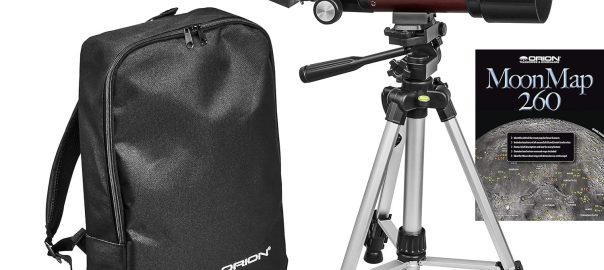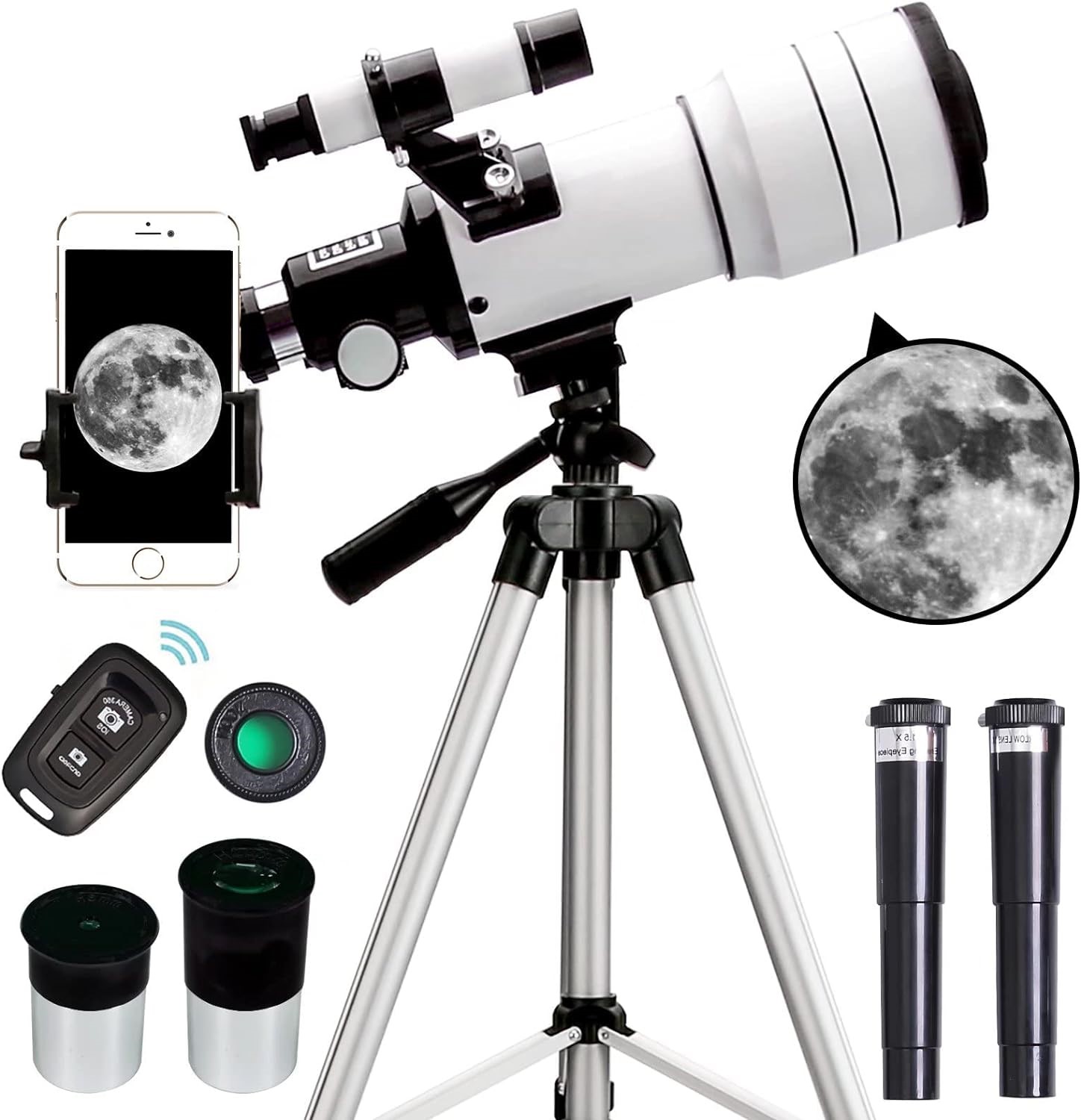Best Telescope for Adults in 2023

| Telescope Model | Aperture (mm) | Focal Length (mm) | Mount Type |
|---|---|---|---|
| Celestron StarSense Explorer | 80 | 900 | Altazimuth/Equatorial |
| Skywatcher Evostar-90 Telescope | 90 | 900 | Equatorial |
| ACTBOT Telescope for Adults | 70 | 400 | Altazimuth |
| ToyerBee Telescope for Adults | 76 | 700 | Altazimuth |
| Meade Instruments Infinity Telescope | 70 | 700 | Altazimuth |
| Celestron NexStar 4SE Telescope | 102 | 1325 | Altazimuth/Equatorial |
| ABOTEC Telescope for Adults | 70 | 400 | Altazimuth |
| BeaverLAB TW1 Pro Telescope | 70 | 400 | Altazimuth |
| Popular Science StarSense Explorer | 80 | 900 | Altazimuth/Equatorial |
| Orion GoScope III Telescope | 70 | 400 | Altazimuth |
Are you ready to explore the wonders of the cosmos? In this article, we present a curated selection of the best telescopes for adults. Whether you’re a beginner or an experienced astronomer, having a high-quality telescope is essential for observing celestial objects with clarity and detail. Join us as we delve into the features, performance, and versatility of these top telescopes that will elevate your astronomical adventures to new heights.
Celestron StarSense Explorer
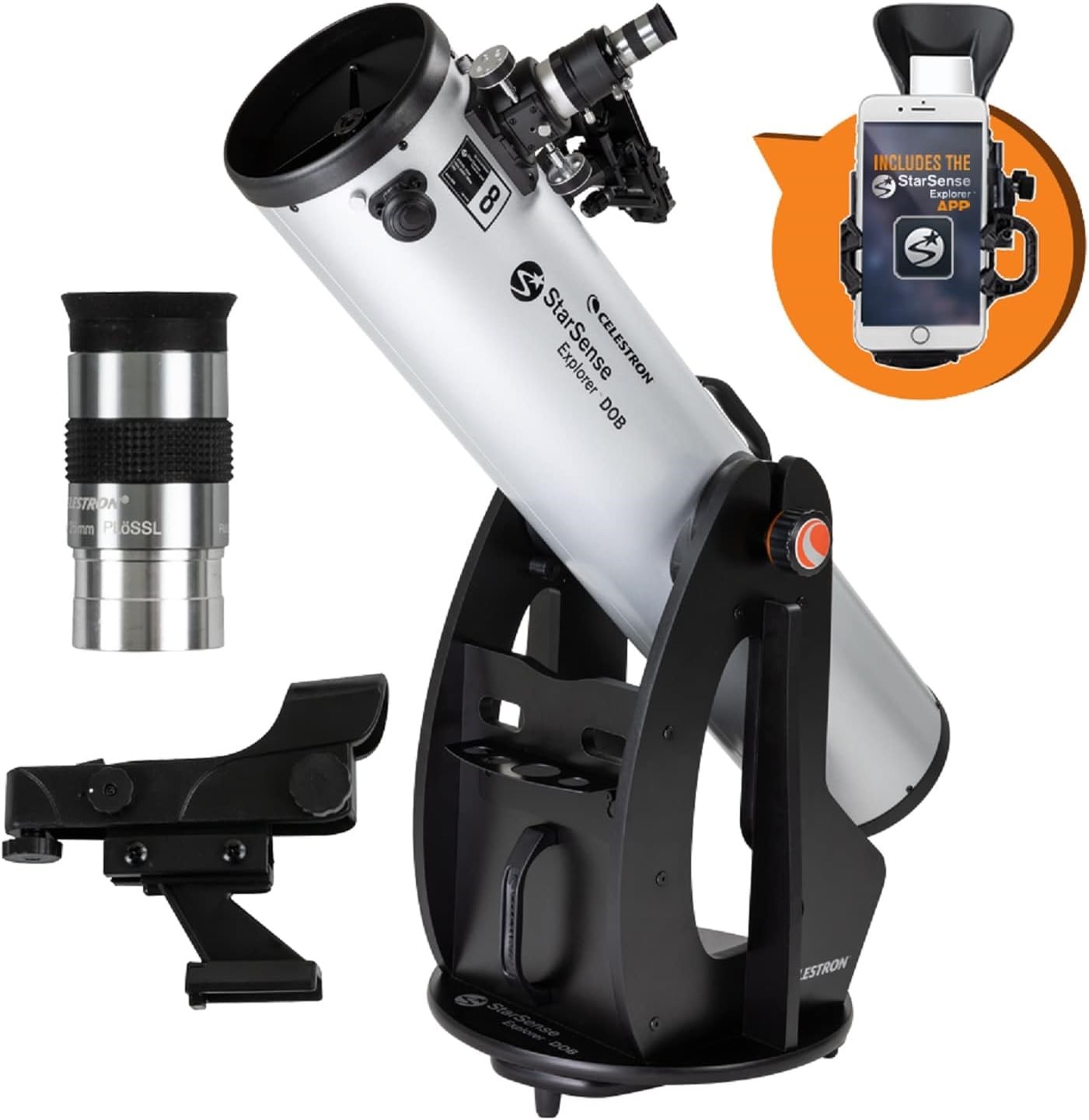
The Celestron StarSense Explorer is an innovative, user-friendly telescope that makes stargazing accessible and enjoyable, earning a solid 4 out of 5 stars.
Key Stats:
- 5-inch aperture for stunning views of celestial objects
- StarSense smartphone app for easy navigation and object identification
- Collapsible design for portability and storage
Reasons to buy:
The Celestron StarSense Explorer is perfect for beginners and enthusiasts alike, with its advanced smartphone app integration that simplifies the process of locating and identifying celestial objects. The 5-inch aperture offers beautiful and detailed views of planets, star clusters, and other deep-sky objects. Its collapsible design makes it portable, allowing you to take it on trips or store it away easily when not in use.
Reasons not to buy:
Though the StarSense Explorer makes finding objects in the night sky simpler, it may not always be completely accurate which may require manual adjustments. Additionally, the smartphone usage may drain more battery and will require a stable internet connection, which isn’t always available in remote observing locations. Lastly, the price might be slightly higher for those new to the hobby and just looking to try it out before committing to a more advanced telescope.
Pros:
- User-friendly smartphone app for easy navigation
- Decent aperture size for clear and detailed images
- Collapsible and portable design
Cons:
- Limited accuracy in object finding and tracking
- Reliance on smartphone battery and internet connection
- Potentially high price for first-time users
Skywatcher Evostar-90 Telescope
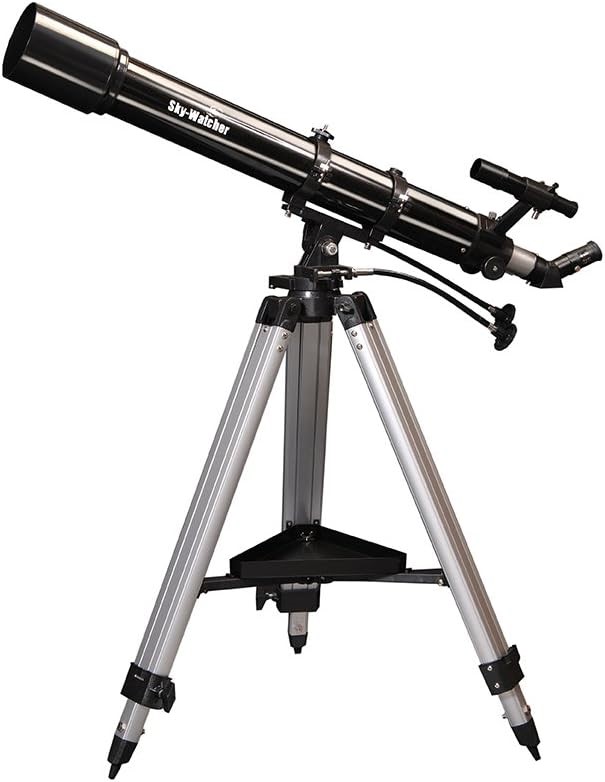
The Skywatcher Evostar-90 Telescope is a versatile and reliable choice for stargazing enthusiasts, receiving a solid 4 out of 5 stars.
Key Stats
- Aperture: 90mm (3.54 inches)
- Focal Length: 910mm (35.8 inches)
- Mount Type: Equatorial
Reasons to buy:
The Skywatcher Evostar-90 Telescope offers a great balance of quality, performance, and affordability for beginner and intermediate users. Its 90mm aperture is capable of gathering sufficient light to provide detailed images of planets, moons, and deep-sky objects, while the 910mm focal length offers a wide range of magnification options. Moreover, the included equatorial mount ensures smooth tracking and easy alignment, making it an excellent choice for those keen on astrophotography or extended observation sessions.
Reasons not to buy:
While the Skywatcher Evostar-90 Telescope is a decent starter scope, it might not satisfy more experienced or advanced users seeking higher-end features and performance. The 90mm aperture, though sufficient for many purposes, might leave some wanting more light-gathering capability for better resolution and detail. Additionally, the lack of a computerized or motorized tracking system may deter those who prefer a more automated experience or who are looking to upgrade to a more sophisticated instrument.
Pros:
- Good aperture and focal length for the price
- Easy to assemble and set up
- Equatorial mount for smooth tracking
- Suitable for both planetary and deep-sky observation
Cons:
- May not satisfy advanced users
- Lacks computerized or motorized tracking
- Limited light-gathering capability compared to larger scopes
- Heavier than some alternatives
ACTBOT Telescope for Adults
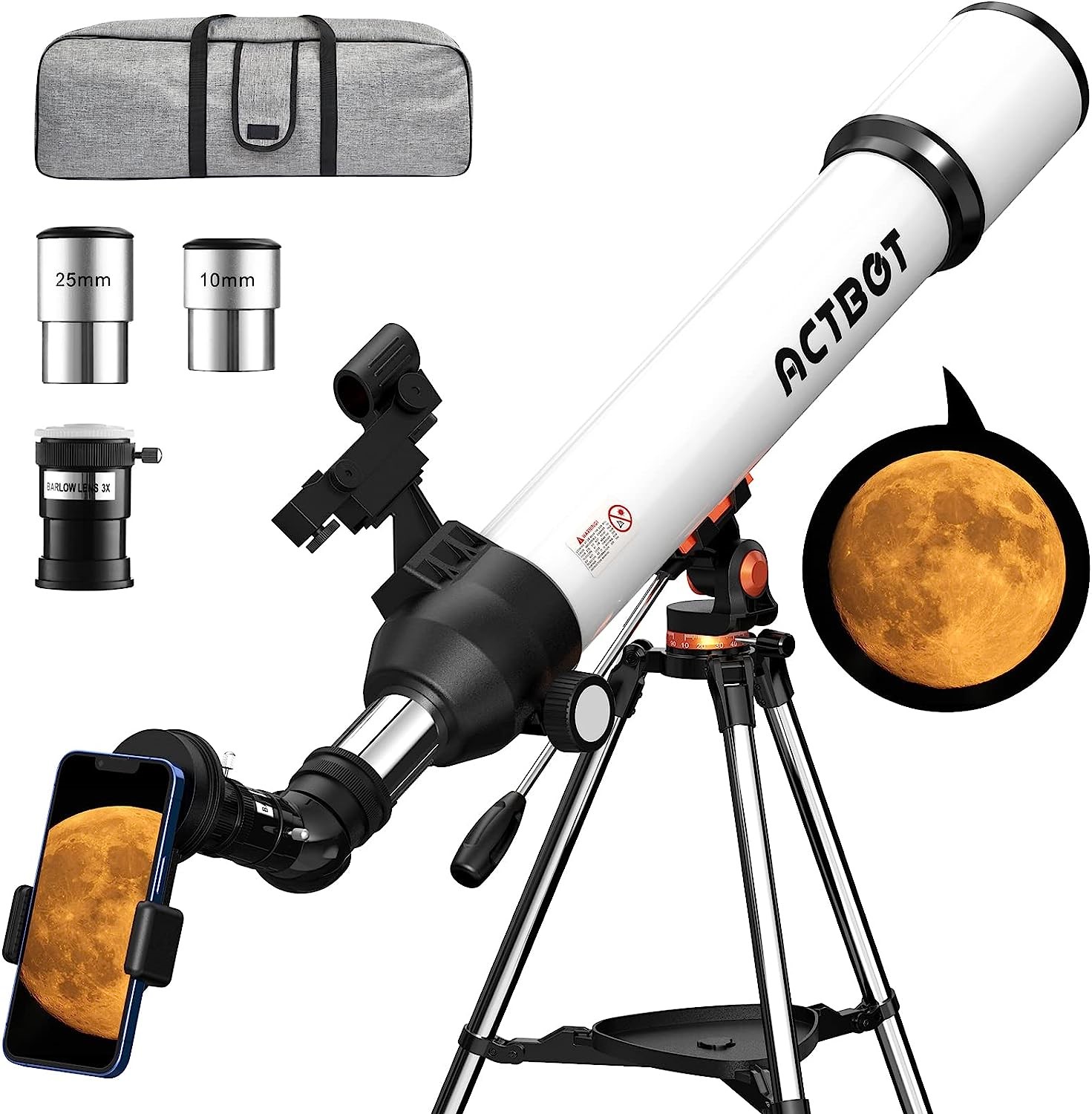
The ACTBOT Telescope for Adults is a high-quality and versatile telescope that offers incredible stargazing experiences, earning a 4.5 out of 5 stars rating.
Key Stats:
- Magnification: Up to 300x
- Aperture: 70mm
- Weight: 5.7 lbs
Reasons to buy:
The ACTBOT Telescope for Adults has a user-friendly design, making it perfect for beginners and experienced astronomers alike. Its 70mm aperture and 300x magnification allow for impressive views of the night sky, while the telescope’s sturdy construction ensures that it will stand the test of time. Additionally, the ACTBOT Telescope offers a lightweight and portable design, ideal for those who love to stargaze on the go or easily transport their equipment for optimal viewing opportunities.
Reasons to not buy:
The ACTBOT Telescope for Adults may be limited in terms of deep-sky observation. While the telescope is capable of providing fantastic views of the moon and nearby planets, it may not be the best choice for those seeking more advanced, professional-level astronomy equipment. Another potential drawback is its lightweight construction, which may not be as ideal for users who prioritize highly sturdy and stable equipment.
Pros:
- User-friendly design
- Impressive 300x magnification
- 70mm aperture for great image clarity
- Lightweight and portable
- Sturdy construction
Cons:
- Limited deep-sky observation capabilities
- May not be suitable for advanced users
- Lighter construction may not be ideal for some users who prefer more stability
ToyerBee Telescope for Adults
The ToyerBee Telescope for Adults is an excellent entry-level telescope designed for amateur stargazers, earning a 4.5 out of 5 rating.
Key stats:
- Magnification: Up to 200x
- Objective lens diameter: 70mm
- Telescope weight: 5.7 lbs
Reasons to buy:
The ToyerBee Telescope is perfect for those new to astronomy, as it offers simple and straightforward setup. With a 70mm aperture, it provides clear and detailed views of the moon, planets, and brighter deep-sky objects. The 3x Barlow lens included enhances the magnification power up to 200x, making it a versatile telescope for various celestial objects. Its lightweight and portable design make it convenient to transport to different viewing locations, while the affordable price makes it an excellent value for beginner enthusiasts.
Reasons to not buy:
While the ToyerBee Telescope is perfect for beginners, more experienced stargazers might find the 70mm aperture and available magnification lacking for detailed observation of fainter objects. Its lightweight design also makes it more prone to shake and instability, possibly affecting the viewing experience. Lastly, the provided eyepieces may not be of the highest quality, potentially requiring additional investment in better lenses for enhanced views.
Pros:
- Easy setup for beginners
- Clear and detailed views of the moon, planets, and bright deep-sky objects
- Versatile magnification options with included 3x Barlow lens
- Lightweight and portable design
- Affordable price for entry-level enthusiasts
Cons:
- Aperture and magnification might not be sufficient for more experienced stargazers
- Lightweight design can lead to instability
- Included eyepieces may not be of the highest quality
Meade Instruments Infinity Telescope
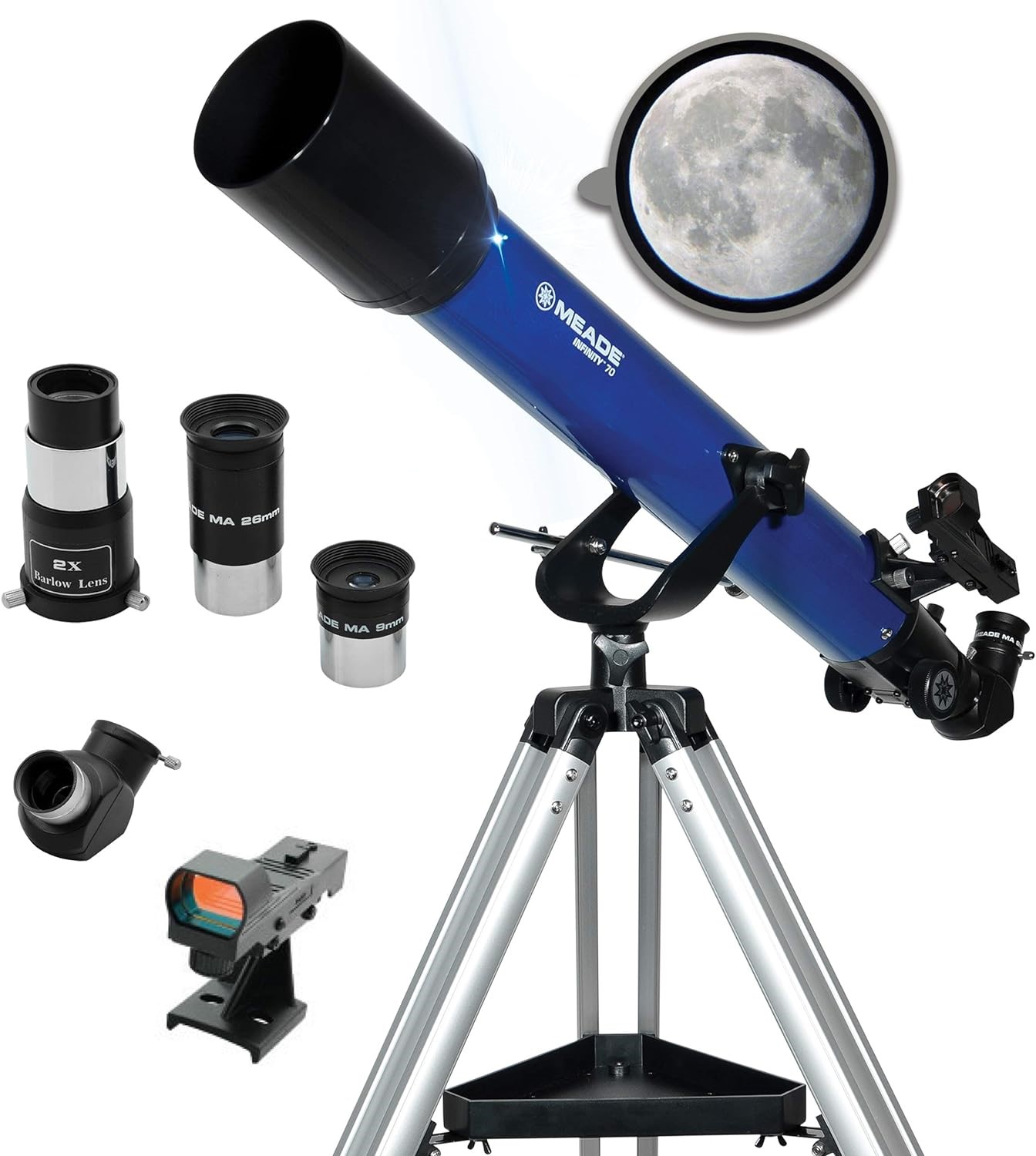
The Meade Instruments Infinity Telescope is an ideal entry-level telescope, earning a 4 out of 5 rating for its user-friendly design, high-quality optics, and affordable price.
Key Stats:
- Aperture: 70mm (2.8 inches)
- Focal Length: 700mm (27.6 inches)
- Mount: Altazimuth
Reasons to buy:
The Meade Instruments Infinity Telescope makes an excellent choice for beginners due to its ease of use and minimal assembly required. This telescope comes with a sturdy altazimuth mount that provides smooth tracking of celestial objects, making observing stress-free. Additionally, the inclusion of three eyepieces (low, medium, and high magnification) offers versatile viewing opportunities, allowing users to explore different targets like planets, stars, and the Moon. Its high-quality optics deliver sharp images, and the affordable price offers an accessible entry into the world of astronomy, making it a fantastic starter telescope.
Reasons not to buy:
While the Infinity Telescope is great for beginners, more experienced stargazers may find its capabilities limited. The 70mm aperture size may not be sufficient for observing faint or deep-sky objects, such as galaxies or nebulae. Furthermore, the included altazimuth mount, although sturdy, may pose issues in terms of precise tracking of objects as compared to an equatorial mount, making it less suitable for astrophotography or long observation sessions.
Pros:
- User-friendly, ideal for beginners
- High-quality optics for clear and sharp images
- Sturdy altazimuth mount for smooth tracking
- Affordable price-point Versatile viewing with three eyepieces included
Cons:
- Not suitable for observing faint or deep-sky objects
- Limited capabilities for experienced stargazers
- Altazimuth mount may not be ideal for astrophotography or precise tracking
Celestron NexStar 4SE Telescope
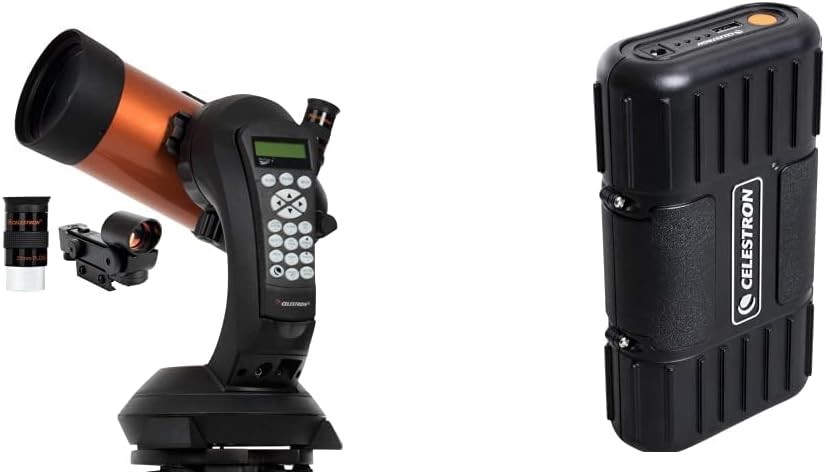
The Celestron NexStar 4SE Telescope is a user-friendly and portable telescope designed for novice and experienced stargazers alike, earning a rating of 4.5 out of 5.
Key Stats:
- Aperture: 102mm (4 inches)
- Focal Length: 1325mm (f/13)
- Computerized GoTo Mount with a database of 40,000 celestial objects
Reasons to buy:
The Celestron NexStar 4SE Telescope has a user-friendly GoTo mount that helps users easily locate and track celestial objects, making it great for beginners. Its compact, portable design is perfect for on-the-go stargazing experiences, and the 4-inch aperture allows for clear and detailed viewing of planets, stars, and deep-sky objects. Additionally, its SkyAlign technology enables quick and easy set-up, ensuring that users spend more time enjoying the night sky rather than struggling with setting up the equipment.
Reasons not to buy:
The Celestron NexStar 4SE Telescope has a relatively high price point, potentially deterring budget-conscious users. The 4-inch aperture, while suitable for most viewing experiences, may not be sufficient for those seeking ultra-detailed, high-resolution images. Lastly, some users might find the battery-power dependence to be an inconvenience when stargazing in remote locations.
Pros:
- Easy-to-use computerized GoTo Mount
- Compact and portable design
- SkyAlign technology for quick and easy set-up
- Suitable for beginners and experienced users
Cons:
- Relatively high price point
- 4-inch aperture might not satisfy users seeking high-resolution images
- Battery-power dependence can be inconvenient in remote locations
ABOTEC Telescope for Adults
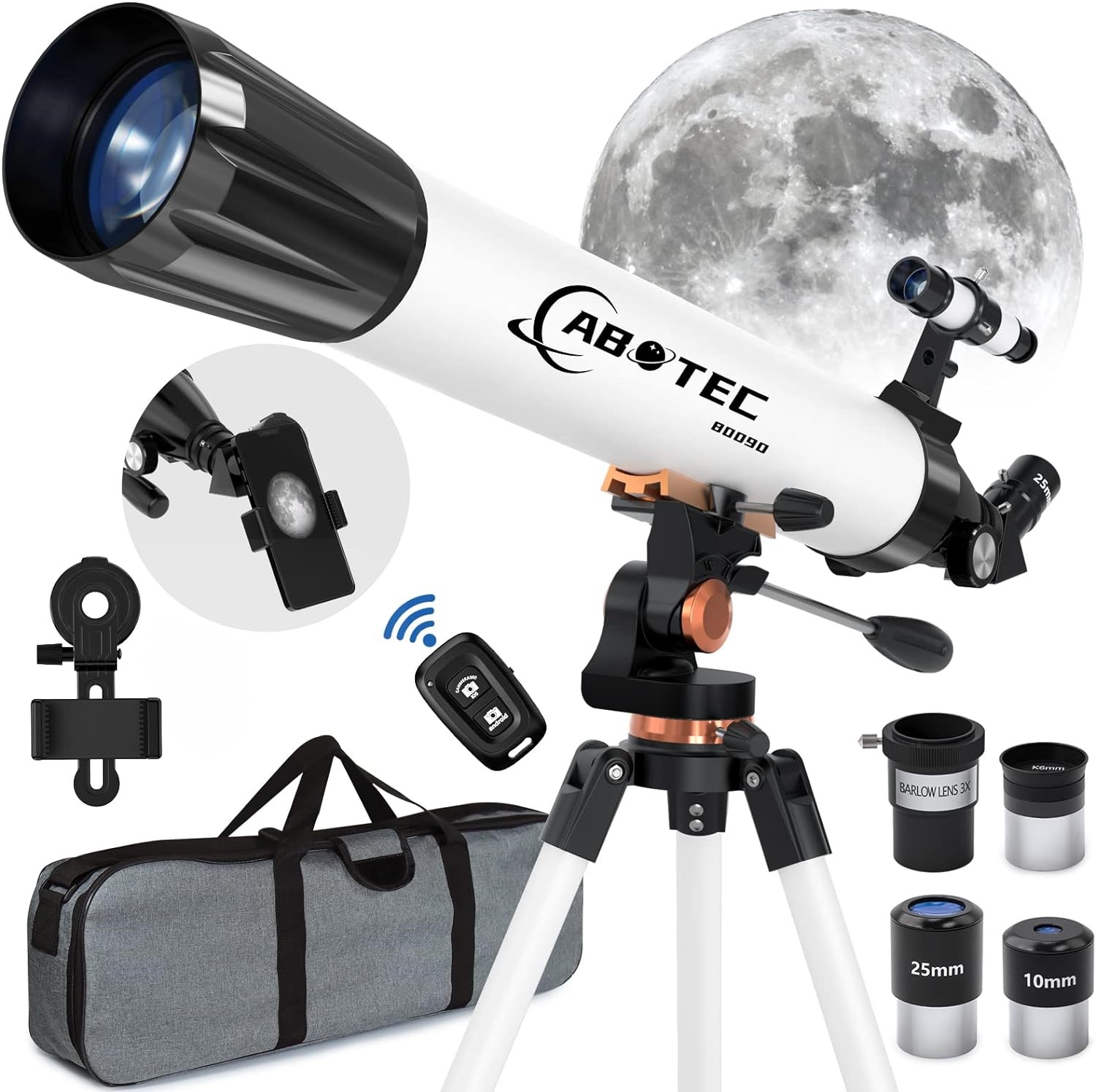
The ABOTEC Telescope for Adults is a versatile and user-friendly telescope, perfect for both beginners and experienced stargazers, earning a rating of 4.5 out of 5 stars.
Key Stats:
- 70mm aperture
- 300mm focal length
- 15-150x adjustable magnification
Reasons to buy:
This telescope offers excellent value to those who want to delve into the world of astronomy. Its 70mm aperture and 300mm focal length provide clear, bright views of celestial objects such as planets, star clusters, and nebulae. The adjustable magnification ranging from 15x to 150x grants versatility that allows both novice and experienced users to explore the sky with ease. Additionally, the lightweight, portable design and simple setup make this an excellent choice for users of all ages, whether at home or on the go.
Reasons to not buy:
If you are a professional astronomer or plan to take long exposure astrophotography, the ABOTEC Telescope may not be the best choice for you. Its aperture and focal length might limit the details visible for certain deep-sky objects, and the simple, lightweight design may lack the stability necessary for demanding astrophotography.
Pros:
- Easy to set up and use
- Versatile magnification range (15-150x)
- Lightweight and portable
- Suitable for all ages
- Affordable price
Cons:
- Limited details visible for deep-sky objects
- May not be suitable for demanding astrophotography
- Stability might be insufficient for professional use
BeaverLAB TW1 Pro Telescope
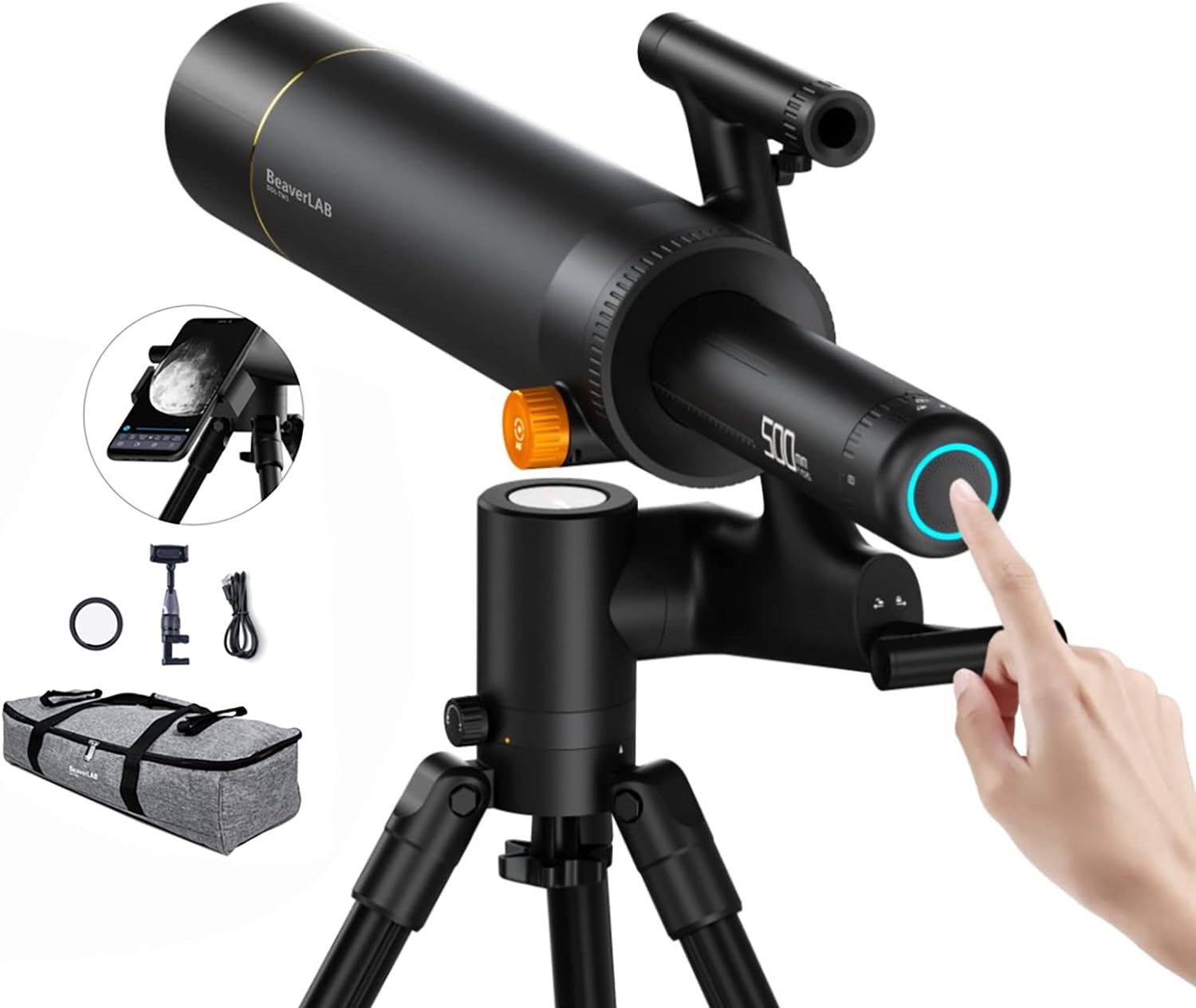
The BeaverLAB TW1 Pro Telescope is a high-quality and reliable device, earning a solid 4.5 out of 5 stars for its advanced features that cater to both beginners and experienced stargazers.
Key Stats:
- 120mm aperture with a 900mm focal length
- Magnification options ranging from 30x to 210x
- Included smartphone adapter for capturing photos
Reasons to buy:
The BeaverLAB TW1 Pro Telescope is a fantastic investment for astronomy enthusiasts who are looking for a versatile and user-friendly device. With its sizable 120mm aperture, you can capture stunning details of celestial objects, while the varied magnification options provide flexibility for viewing objects at different distances. The inclusion of a smartphone adapter is a major selling point, as it allows users to easily take high-quality photos of their observations, making it perfect for sharing on social media or documenting one’s astronomy journey.
Reasons not to buy:
Though the BeaverLAB TW1 Pro Telescope offers many advantages, it might not be the ideal choice for everyone. Its advanced features and price point may be overwhelming for individuals who are just starting out in the world of astronomy and looking for a more basic and budget-friendly option. Additionally, the telescope’s size can make transportation and storage challenging for individuals with limited space in their homes or cars.
Pros:
- Large aperture provides detailed views of celestial objects
- Multiple magnification options for versatility
- Smartphone adapter makes photography easy and accessible
Cons:
- May be intimidating or too advanced for beginners
- Price point may be high for some budgets
- Size can make transportation and storage difficult
Popular Science StarSense Explorer
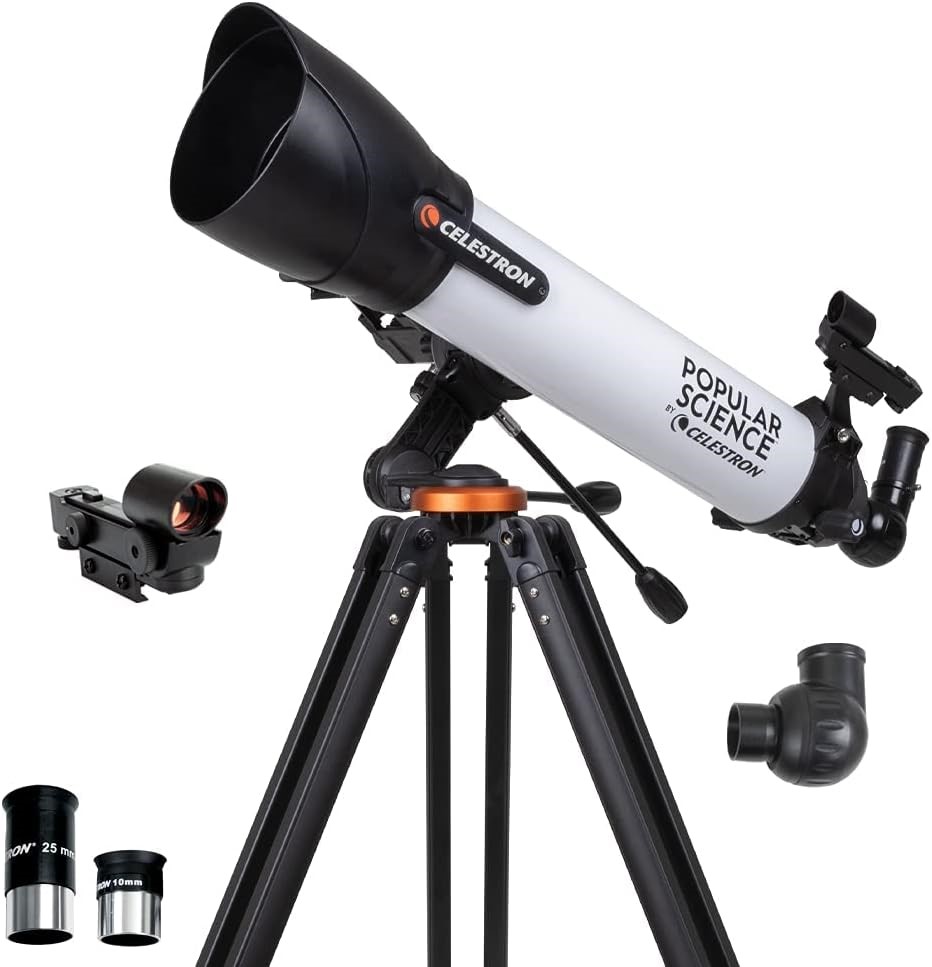
The Popular Science StarSense Explorer is an innovative stargazing tool for astronomy enthusiasts, earning a 4.8 out of 5 stars rating.
Key stats:
- Compatible with a wide range of Celestron telescopes
- Utilizes smartphone technology for easy operation
- Comes with a comprehensive database of 4,000 celestial objects
Reasons to buy:
The Popular Science StarSense Explorer offers users a user-friendly way to explore the cosmos, making it perfect for both beginners and experienced stargazers alike. Its compatibility with various Celestron telescopes ensures that you can find a suitable scope to match your needs. The smartphone integration allows for effortless alignment and tracking of celestial objects, while the extensive database provides a wealth of information to expand your knowledge of the universe.
Reasons to not buy:
While the StarSense Explorer offers many advantages, it may not be ideal for those who prefer traditional stargazing methods without the aid of technology. Furthermore, smartphone compatibility may be limited, potentially excluding some users. The higher price tag may also deter those on a tight budget.
Pros:
- Easy-to-use and ideal for beginners
- Compatible with a range of telescopes
- Smartphone integration simplifies alignment process
- Extensive celestial object database
Cons:
- May not appeal to traditional stargazing purists
- Limited smartphone compatibility
- Potentially higher price point
Orion GoScope III Telescope
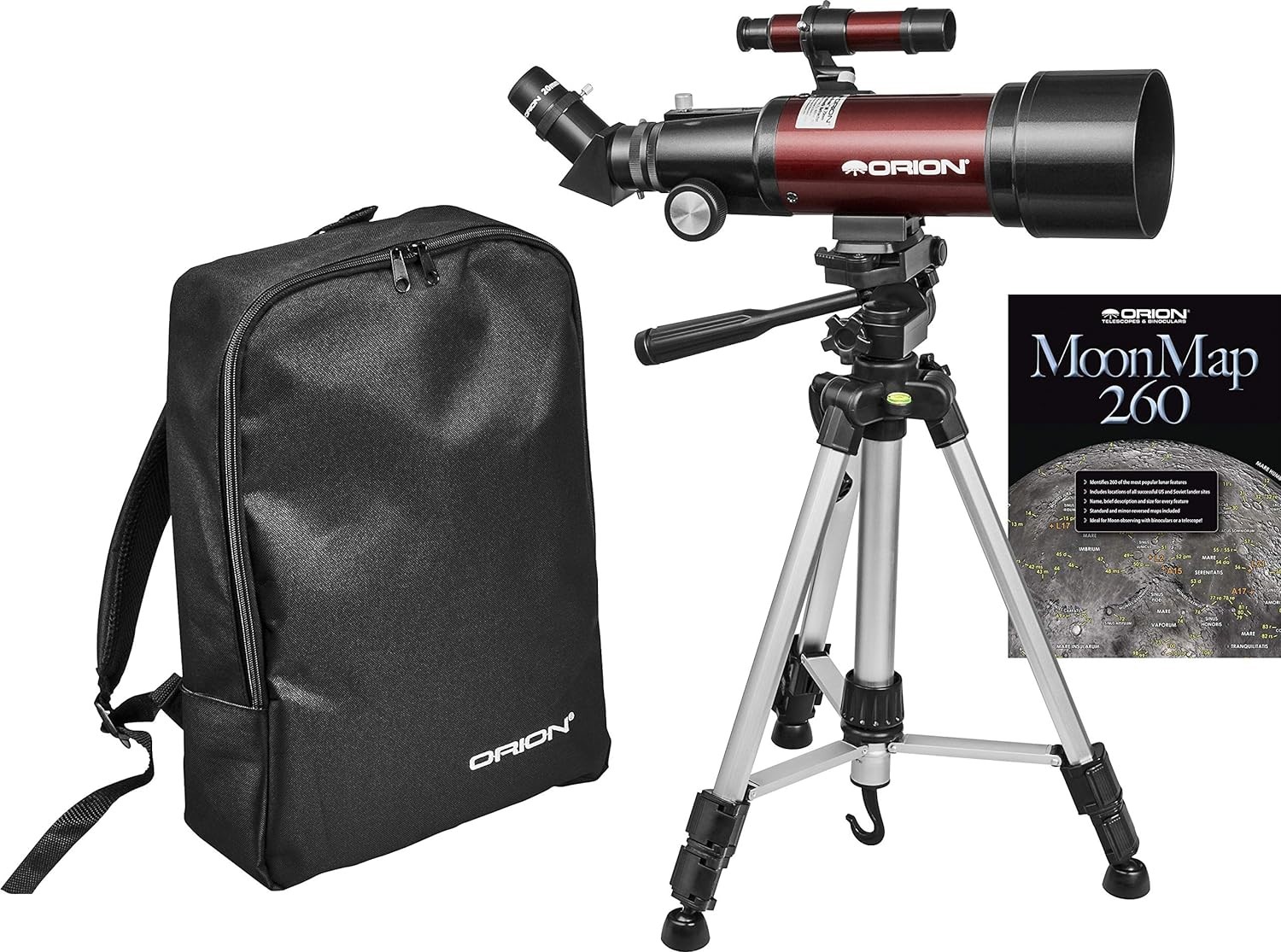
The Orion GoScope III Telescope is a compact and portable grab-and-go telescope perfect for beginners, with a rating of 4 out of 5 stars.
Key stats:
- 70mm refractor optical tube with a focal length of 400mm
- 5×24 finder scope and two 1.25? Kellner eyepieces (20mm and 9mm) included
- Lightweight and collapsible aluminum tripod with pan handle altazimuth mount
Reasons to buy:
The Orion GoScope III is an excellent choice for novice astronomers and young stargazers, as it is affordable, lightweight, and easy to use. The 70mm refractor is powerful enough to view the Moon, planets, and even some deep-sky objects. Its portability allows users to bring the telescope to various locations for enhanced viewing experiences. The included finderscope and eyepieces enhance the telescope’s functionality and provide good resolution and high contrast images. The durable tripod and altazimuth mount not only provide stability but also make it easy to track celestial objects as they move across the sky.
Reasons not to buy:
While the Orion GoScope III is great for beginners, more experienced or dedicated astronomers may find it lacking in terms of features and upgrade options. The 70mm aperture may not be powerful enough for enthusiasts seeking to observe more detail on distant celestial objects. Additionally, the included aluminum tripod may be prone to vibrations and is not as stable as some higher-priced options. The altazimuth mount, although user-friendly, may not provide the tracking precision required for astrophotography.
Pros:
- Affordable and beginner-friendly
- Lightweight and portable
- Adequate aperture and focal length for casual observation
- Included tripod and altazimuth mount
- Good beginner accessories, such as finderscope and eyepieces
Cons:
- May not satisfy more experienced astronomers
- Limited aperture size for distant celestial objects
- Tripod may be prone to vibrations
- Insufficient tracking precision for astrophotography
Frequently Asked Questions (FAQ)
Q: What should I consider when selecting a telescope for adults?
A: When choosing a telescope for adults, consider factors such as the aperture size, focal length, and type of telescope (refractor, reflector, or compound). Additionally, evaluate the stability and accuracy of the mount, ease of use, portability, and the ability to upgrade or add accessories for future needs.
Q: Can I use these telescopes for astrophotography?
A: Some of the telescopes featured in our selection are suitable for astrophotography. Look for telescopes with stable mounts, tracking capabilities, and compatible camera attachments. Keep in mind that astrophotography often requires additional equipment and techniques to capture high-quality images.
Q: Are these telescopes suitable for viewing both terrestrial and celestial objects?
A: While many telescopes are primarily designed for observing celestial objects, some models offer versatility for terrestrial viewing as well. Check for features such as erect-image optics or the ability to attach different eyepieces to optimize the viewing experience for both types of objects.
Q: Do I need any additional accessories with these telescopes?
A: Additional accessories can enhance your observing experience. Eyepieces of varying focal lengths, filters for specific wavelengths, a sturdy tripod or mount, star charts or smartphone apps for object identification, and a good-quality astronomy guidebook are some of the useful accessories to consider.
Q: How can I ensure proper maintenance and care of my telescope?
A: Proper maintenance includes keeping the optics clean, storing the telescope in a safe and dry place, and avoiding exposure to extreme temperatures or humidity. Regularly checking and aligning the telescope, as well as following the manufacturer’s instructions for maintenance, will help ensure optimal performance and longevity.
Conclusion
In conclusion, embarking on a celestial journey through stargazing is an awe-inspiring experience that can enrich our understanding of the universe. The best telescopes for adults in 2023 offer exceptional optics, sturdy constructions, and advanced features to cater to various skill levels and astronomical interests. From observing the moon’s craters to capturing breathtaking images of distant galaxies, these telescopes empower adults to immerse themselves in the beauty and mysteries of the cosmos. Choose the perfect telescope for your astronomical pursuits and embark on a lifelong journey of exploration.
The post Best Telescope for Adults in 2023 appeared first on ReadWrite.
(14)
Report Post